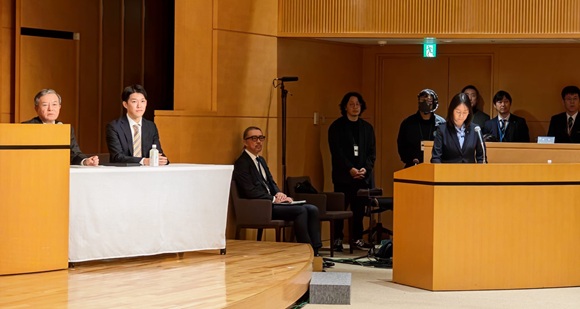NTT R&D Forum 2025: Live keynote report
NTT Inc. CEO Akira Shimada kicked off the NTT R&D Forum 2025 conference this year, with the event itself billed as a “Quantum Leap Into The Future”, this gathering was designed to clarify and explain how the company is driving optical photonics into the quantum space as part of its wider efforts to expand work in its Innovative Optical Wireless Network (IOWN) initiative.
The keynote presentation was officially titled “Towards Advancing Scalable & Reliable Quantum Computers” and with simultaneous translation headsets plugged in, the global press group dived in.
Shimada covered his firm’s news with OptQC Corp, a collaboration agreement to realise a 1-million qubit optical quantum computer by 2030.
The union between the two companies has been aligned on both a commercial business and technology level… with only a few hundred quantum machines on the planet right now, Shimada explains that the firms have plans to get that number into the thousands.
With issues such as power consumption and the fragile nature of quantum states that need to be taken into account when developing these machines, energy efficiency is a big part of this story.
Innovative Optical Wireless Network
Developed as part of the Innovative Optical and Wireless Network (IOWN) Initiative to OptQC’s quantum computing platform to commercialise practical, scalable and reliable optical quantum computers.
With a one-million-qubit machine at our disposal, humans will be able to materialise a society that is capable of solving huge problems such as “personalising drug medication to each individual” and other challenges that are currently thought of as practically impossible.
Giving way to the CEO of OptQC itself (Hiroshi Takase), the presentation continued to expand with a deeper explanation of the so-called “super machines” that we will be building when quantum computing manufacturing is truly brought online. The firms want to “reclaim Japan’s number one” position in computer manufacturing.
NOTE: Just for some colour, readers will note that “Japan number one” in Japanese is spoken as “Japan number one”, which on a global scale kind of makes sense.
Speakers drilled deeper into the most likely use cases for quantum machines at this level what role AI will play. Given that this is still a comparatively early stage in some senses, NTT explains that it is working with the University of Tokyo to help drive the development in this space alongside its own research engineers.
Beyond current energy limitations
IOWN Photonic Computing involves converting electricity into light to surpass the energy limitations that currently exist. Further, an optical quantum computer is capable of overcoming the limits of computation using quantum technology on its own.
Optical communication can be used that consumes almost no additional power (once established) over increasingly long distances. Because AI workloads using large numbers of GPUs require frequent, high-volume data transfers between GPUs, existing networks will reach their capacity perhaps faster than many of the AI, cloud and GPU advocates imagine.
Because GPUs are built on electrical wiring, NTT says that (even over short distances) a huge amount of electrical power is required. The company says that optical wiring offers huge efficiencies across the following device areas (year of development shown in brackets):
- For transmission equipment (2023)
- Datacenter and server interconnects (2023)
- Board-to-board interconnects (2025)
- Package-to-package interconnects (2028 onwards)
- Die-to-die interconnects (2032 onwards)
So we are talking about the development and manifestation of computers with one-eighth power consumption of traditional machines, demonstrated as a working device here in Tokyo this November 2025. The machine was built with optical hardware, software and architecture
Covering NTT partnerships with Broadcom to enrich the supply chain in the communications market, CEO Shimada held his position in the keynote stage for some 45 minutes while also fielding technical questions from the press in attendance.
Shimada covered the “basics” of quantum superposition theory for the audience (you know the score by now, qubit values can be not just one or zero, but one, zero and every number in between) so what matters now is how fast we can get to machines that can handle one million qubits… and this is the central mission for NTT in relation to the developments on show here this week.
Light source purity
The optical quantum approach has fewer constraints than “traditional old-fashioned” quantum computers; perhaps the most significant of which is the fact that they can (in some scenarios) perform at room temperature. NTT says it is working to make sure the “light source” technologies it employs at this level are extremely pure in order to maximise efficiencies.
With so much other work on show at the NTT R&D Forum across various computing platforms (including the company’s own large language model) and a whole range of its hardware devices and networking infrastructure capabilities, the company focused almost wholly on quantum for this year’s keynote.
Quantum, built on light-based optical photonics, may just be that bit closer.

The NNT board panel in Tokyo, this November 2025.




